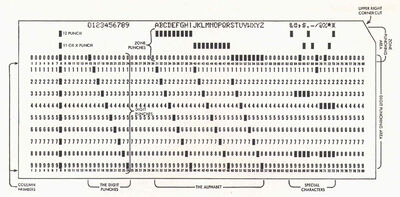Historical Background[]
In the late 1800s, the U.S. government was facing a data processing crisis of sorts. It was taking the U.S. Census Bureau more than a decade to perform and report the results of the Census, which is required by law to be taken every ten years. Something had to be done to tame the flood of census data that was overwhelming the manual tabulation methods used.
Herman Hollerith was a Census Bureau employee, who developed an electronic tabulating system using punched tapes, and later punched cards. His system represented information as a series of holes on a punched card. Each column of the card could represent to a single fact, yes or no answer, or number. In 1884, Hollerith filed a patent on the punched tape system, and later the punched card system. Hollerith's company (The Tabulating Machine Company), through a series of acquisitions and name changes, eventually became IBM.
The Technology[]

IBM 80-column punched card
The Hollerith machines used what became the ubiquitous 80 column "IBM Hollerith cards." Unfortunately, the 80 column cards imposed limitations on the amount of data that could be recorded on each card. Only 80 bytes of data (1 byte equals 1 character of data) were available. If, the data could be shortened, then there would be more available space for additional information.
If data for a particular record spanned more than one card, the developer/programmer would have to sequentially number the cards so that they could be sorted correctly and organized properly if the cards were accidentally dropped. This meant that even more data was used up for control purposes, as opposed to unique data associated with a particular record.
One solution to squeezing more data on each card was to remove any redundant data. One situation where this occurred was to eliminate the first two digits of the year from a date, so that “1915” would be entered as simply “15.” If there were several dates on one card, two bytes could be saved for each date. This worked perfectly well as long as all of the dates were in a single century. However, as the world approached the beginning of the 21st Century, people realized that the shortening of dates would cause problems as soon as computers had to store dates for two different centuries. This was the genesis of the Year 2000 problem.